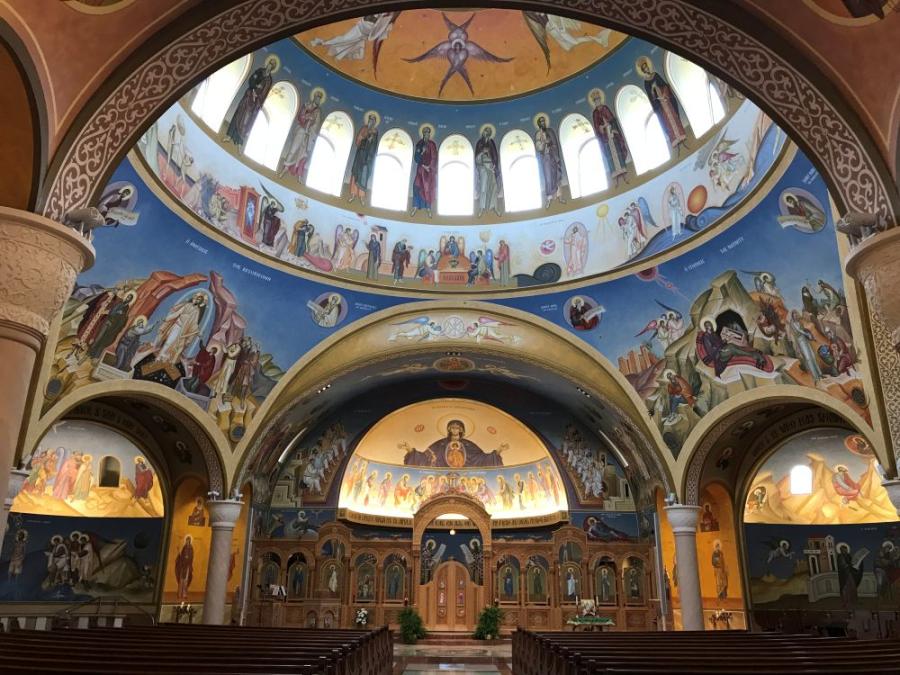
Welcome to the first in a series of how we move through space in our churches, by liturgist, chanter, and mother Sarah Roumas.
The narthex is a place of preparation, I have been taught. It is the transition between the secular and the sacred. It is a place where I must remember to pause so that I can release the cares of the world, I can ready myself for what is to come. I complete the slow tasks of lighting a candle and venerating the icons in order to compose myself for the time of prayer, before hurrying—at least a little slower now—into church.
And then I became a mother.
The narthex in traditional commentaries is the place of the catechumens, the penitents, and those possessed by demons, and thus the place where our Lord most naturally gravitates, if we are to believe the Gospels. Today, however, it is the place of the crying babies, their parents, and the parish council. Is this an error, a sign of the modern failure to worship correctly? Could we believe that the Holy Spirit today persists only in the nave and the altar, having deserted the narthex when it became filled with those already baptized? Of course not. The narthex is not a heavenly coat-closet where the majority pass through in order to shed their muddy boots and the unlucky minority find themselves condemned to wait. The narthex, now, to me is not a place of preparation in any sense beyond the sense in which life itself is a place of preparation, all of worship is a place of preparation. The narthex is a place of welcome, God’s welcome, the radical hospitality of that beloved Nazarene who plumped the crowds right down where they stood and showered them with bread and fish.
The narthex is no longer a gate for me to pass through, a barrier which slows my entry and attempts to orient me before I get on to the real work of worship. Now in worship I flow, gently and surprisingly easily, between the nave and the narthex, the narthex and the nave, with the occasional incursion into the cry room. Now the narthex is no longer content with turning my orientation slightly towards the east and aiming me into the nave. It pulls me round in tight circles, halting all forward progress. And now, of course, I see the true reality of the narthex, the things I missed on my busy ingresses in prior days. Now I know the others who spend their Sunday mornings in, or largely in, the narthex, minding children and candles and donation trays and prayer-request slips. The narthex is no longer a place of preparation before worship.
I remember, now, that it wasn’t always that to me either. When I was in seminary, I joined an ‘altar group’ which was responsible for the chapel one week out of four. As the only woman, of course, the ‘altar group’ for me was, indeed, the ‘narthex group’, since I could not enter the altar and participate in the tasks which were to be done there. Instead, I spent one week each month in the narthex, mostly trying to focus on the words and music which came through tinny speakers in the ceiling, but occasionally called into service to supply directions, Kleenex, once a towel to a woman who’d been caught in a thunderstorm. I left the ‘narthex group’ with some relief at the end of the school year, very pleased that my habitual place in worship shifted farther east to the chant stand, and had nearly forgotten it until the needs of my baby tugged me back to the west.
Historically, churches have adorned their narthexes with icons of the Last Judgment or icons of the parables—strange bedfellows, but finding common ground for me in this idea of welcome. What is the Last Judgment if not the moment when God’s arms finally open, fiercely embracing all of His own in an eternity of love, separating for ever the negation and privation of hatred and cruelty and small-minded evil? What are the parables but God’s most gentle form of incarnation, sidling into our world in an allegory, and taking to Himself all life’s dusty details?
In the narthex, I see the ghost of my former self, hurrying inside and then hurrriedly instructing myself not to hurry, because I am on the way to worship—as if worship depended on what I remembered to do, on my imperfect desire to pray and my inconsistent ability to follow my own desires. I tried to think myself into the mentality for worship, using the room as an icon-decorated self-help space. The narthex, like the rest of the church, is the place where God most clearly reveals Himself to us. Worship, being an encounter between creatures and Creator, the finite and the infinite, cannot be attained by my attempts to tug myself up by spiritual bootstraps. The narthex creates this first space where the encounter is possible; God Himself chooses to come and meet us there.
Sarah Roumas received a bachelor’s degree in physics from Harvard University, a master of theological studies and a master of theology degree from Holy Cross Greek Orthodox School of Theology in Brookline, Massachusetts, and a Ph.D in liturgical theology from the University of Notre Dame. She studies the development of the Byzantine liturgical books and biblical interpretation in Byzantine hymns. Her dissertation was on the hymns of Lazarus Saturday in Greek manuscripts of the Triodion. She is currently a postdoctoral fellow at the University of Notre Dame in South Bend, Indiana, where she chants at St. Andrew’s Greek Orthodox Church and lives with her husband Nicholas and baby son, Anthony.


